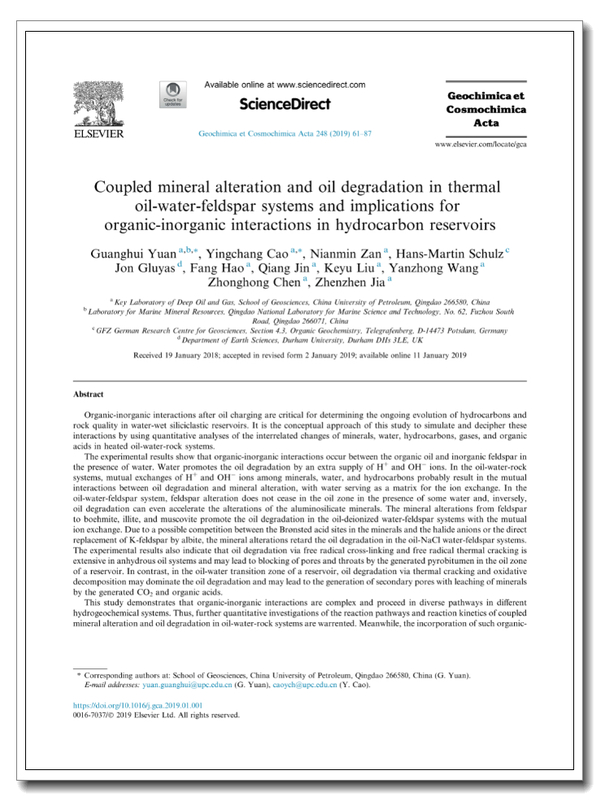Guanghui Yuan, Yingchang Cao, Nianmin Zan, Hans-Martin Schulz, Jon Gluyas, Fang Hao, Qiang Jin, Keyu Liu, Yanzhong Wang, Zhonghong Chen, Zhenzhen Jia
Coupled mineral alteration and oil degradation in thermal oil-water-feldspar systems and implications for organic-inorganic interactions in hydrocarbon reservoirs
Geochimica et Cosmochimica Acta, ISSN: 0016-7037
https://doi.org/10.1016/j.gca.2019.01.001
Abstract:
Organic-inorganic interactions after oil charging are critical for determining the ongoing evolution of hydrocarbons and rock quality in water-wet siliciclastic reservoirs. It is the conceptual approach of this study to simulate and decipher these interactions by using quantitative analyses of the interrelated changes of minerals, water, hydrocarbons, gases, and organic acids in heated oil-water-rock systems.
The experimental results show that organic-inorganic interactions occur between the organic oil and inorganic feldspar in the presence of water. Water promotes the oil degradation by an extra supply of H+ and OH− ions. In the oil-water-rock systems, mutual exchanges of H+ and OH− ions among minerals, water, and hydrocarbons probably result in the mutual interactions between oil degradation and mineral alteration, with water serving as a matrix for the ion exchange. In the oil-water-feldspar system, feldspar alteration does not cease in the oil zone in the presence of some water and, inversely, oil degradation can even accelerate the alterations of the aluminosilicate minerals. The mineral alterations from feldspar to boehmite, illite, and muscovite promote the oil degradation in the oil-deionized water-feldspar systems with the mutual ion exchange. Due to a possible competition between the Brønsted acid sites in the minerals and the halide anions or the direct replacement of K-feldspar by albite, the mineral alterations retard the oil degradation in the oil-NaCl water-feldspar systems. The experimental results also indicate that oil degradation via free radical cross-linking and free radical thermal cracking is extensive in anhydrous oil systems and may lead to blocking of pores and throats by the generated pyrobitumen in the oil zone of a reservoir. In contrast, in the oil-water transition zone of a reservoir, oil degradation via thermal cracking and oxidative decomposition may dominate the oil degradation and may lead to the generation of secondary pores with leaching of minerals by the generated CO2 and organic acids.
This study demonstrates that organic-inorganic interactions are complex and proceed in diverse pathways in different hydrogeochemical systems. Thus, further quantitative investigations of the reaction pathways and reaction kinetics of coupled mineral alteration and oil degradation in oil-water-rock systems are warrented. Meanwhile, the incorporation of such organic-inorganic reactions into geochemical models will improve the prediction of the evolution of organic and inorganic species in petroleum reservoirs.


